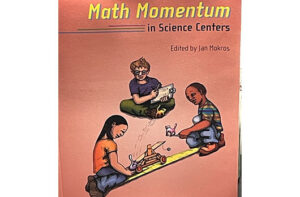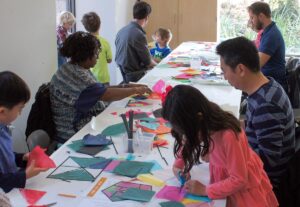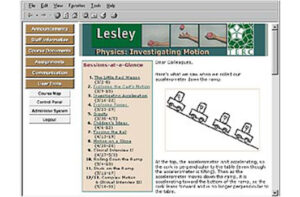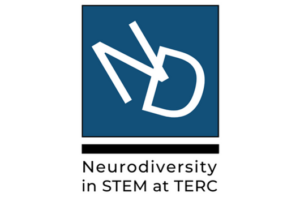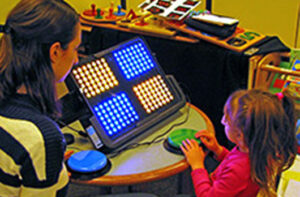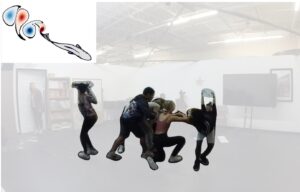Sound Travels
Lead Staff:
Martha MersonProject Staff:
Elise Levin-GüracarLead Staff Outside TERC
Justin Reeves Meyer
Daniel Shanahan
Joe Heimlich
Nickolay Hristov
Advisors
Cesar Almeida, Solidarity Studios
Eric Leonardson, Midwest Society for Acoustic Ecology
Victor Minces, University of California, San Diego
Eve Payor, Atlantic Center for the Arts
Amaris Alanis Ribeiro, North Park Village Nature Center
Christopher Wright, Drexel University
Project SummarySounds capture attention. Sounds of all sorts (from bird song to bus noise) can change how we learn and interact in different settings. Sounds can have an emotional and physical impact too. You may know people who are triggered by loud noises or who calm down when they hear music they like. We are investigating how sounds around us (soundscapes) impact people and their learning outside school in spaces like parks, zoos, and science centers.
Research ActivityThe Sound Travels team (partners and researchers) have four years to:
1) Understand soundscapes as they exist in different informal learning environments like zoos, parks, and science centers. They will identify specific spots, exhibits, and programs to investigate.
2) Collect data, analyze, and interpret the relationships between sounds and learning
- What qualities of sounds attract attention?
- What qualities of sound hold attention?
- What qualities of sounds seem to connect with social learning (conversations, figuring out puzzles, learning together (siblings, caregivers, and children)?
3) Share findings with those who will help prioritize questions, laying the groundwork for future research.
The team expects to tease out relationships and then share insights to help informal STEM professionals design and plan for increased attraction, attention, and shared learning among visitors.
Building on findings related to psychological impact Sound Travels approaches are well-aligned with the factors important for psychological impact (Lester et al., 2018) including attention to:
- the inter-related constructs of relevance, salience, attention, interest and engagement
- the relationships between attention and memory (recall and recognition)
- indicators of a higher sense of presence, which increases empathy and connection
Lead Staff Outside TERC
Justin Reeves Meyer
Daniel Shanahan
Joe Heimlich
Nickolay Hristov
Advisors
Cesar Almeida, Solidarity Studios
Eric Leonardson, Midwest Society for Acoustic Ecology
Victor Minces, University of California, San Diego
Eve Payor, Atlantic Center for the Arts
Amaris Alanis Ribeiro, North Park Village Nature Center
Christopher Wright, Drexel University
Sounds capture attention. Sounds of all sorts (from bird song to bus noise) can change how we learn and interact in different settings. Sounds can have an emotional and physical impact too. You may know people who are triggered by loud noises or who calm down when they hear music they like. We are investigating how sounds around us (soundscapes) impact people and their learning outside school in spaces like parks, zoos, and science centers.
Research ActivityThe Sound Travels team (partners and researchers) have four years to:
1) Understand soundscapes as they exist in different informal learning environments like zoos, parks, and science centers. They will identify specific spots, exhibits, and programs to investigate.
2) Collect data, analyze, and interpret the relationships between sounds and learning
- What qualities of sounds attract attention?
- What qualities of sound hold attention?
- What qualities of sounds seem to connect with social learning (conversations, figuring out puzzles, learning together (siblings, caregivers, and children)?
3) Share findings with those who will help prioritize questions, laying the groundwork for future research.
The team expects to tease out relationships and then share insights to help informal STEM professionals design and plan for increased attraction, attention, and shared learning among visitors.
Building on findings related to psychological impact Sound Travels approaches are well-aligned with the factors important for psychological impact (Lester et al., 2018) including attention to:
- the inter-related constructs of relevance, salience, attention, interest and engagement
- the relationships between attention and memory (recall and recognition)
- indicators of a higher sense of presence, which increases empathy and connection
The Sound Travels team (partners and researchers) have four years to:
1) Understand soundscapes as they exist in different informal learning environments like zoos, parks, and science centers. They will identify specific spots, exhibits, and programs to investigate.
2) Collect data, analyze, and interpret the relationships between sounds and learning
- What qualities of sounds attract attention?
- What qualities of sound hold attention?
- What qualities of sounds seem to connect with social learning (conversations, figuring out puzzles, learning together (siblings, caregivers, and children)?
3) Share findings with those who will help prioritize questions, laying the groundwork for future research.
The team expects to tease out relationships and then share insights to help informal STEM professionals design and plan for increased attraction, attention, and shared learning among visitors.
Building on findings related to psychological impact Sound Travels approaches are well-aligned with the factors important for psychological impact (Lester et al., 2018) including attention to:
- the inter-related constructs of relevance, salience, attention, interest and engagement
- the relationships between attention and memory (recall and recognition)
- indicators of a higher sense of presence, which increases empathy and connection

Funder:
National Science Foundation
Award Number:
DRL-2215101
Center for Research & Evaluation
North Park Village Nature Center
Chicago Park District
Franklin Park Conservatory and Botanical Gardens
Metro Parks


